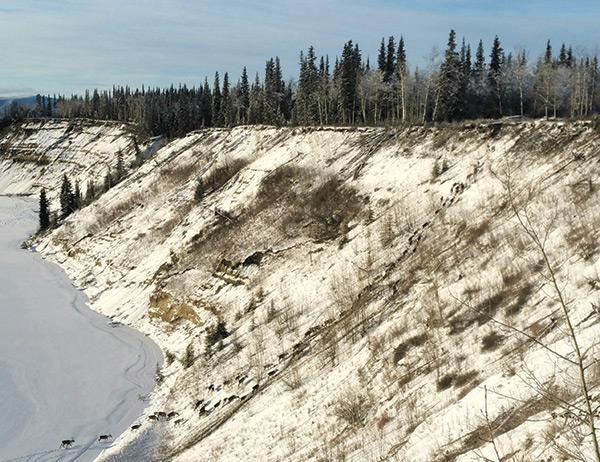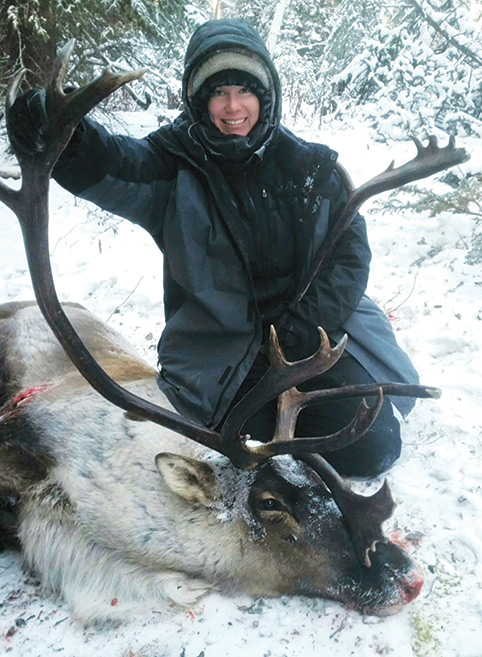 Wilderness Adventure: Alaska Caribou Meat Hunt
Wilderness Adventure: Alaska Caribou Meat Hunt
By Rose Kareem

The day dawned with a clear blue sky. Sunshine glistened through tall spruce onto fresh snow below. It was 15 below. The family was at church, and I was going hunting for needed meat. I donned the several layers of clothing required in the Far North and headed out in search of caribou. Thanks to the recent snowfall, tracking would be easy. The animals had been moving with herds of caribou migrating through. It seemed like there were always wolf, coyote, and lynx tracks in the woods.
My first sighting was a group of about fifty caribou coming up the mountain towards me. The front ones stopped, looking behind to others which had yet to start the climb. When caribou decide to move, they move fast, but I knew exactly where these were headed based on their position. If I could make it there before them, I had a good chance at a shot. The trick was to be swift without being seen. I decided to take a trail that was not a direct route to where I needed to be, hoping to make good time by staying on a clear path. The caribou wouldn’t see or hear me because I was a good distance away.
In a gait between a run and a jog, I passed through the woods—until I landed on my knees with a thud. One of the many hidden, downed trees had reached out of the snow and grabbed my boot. It was a hard fall, and while brushing myself off, I noticed snow and tundra moss packed in the muzzle of the rifle. I had to dig it out. By the time I was done and on my feet again, I had lost nearly a minute.
That may not sound like much, but when racing caribou, every second counts.
Ignoring aching knees, I proceeded.
I slowed when I veered off the path and through the woods headed for the clearing I knew the caribou were also headed towards.
I reached it a few seconds too late. The tail end of the herd was still on a steep slope, and I had a perfect shot at the last five or so. But I didn’t dare shoot. Any caribou I shot there would tumble down the mountain, and no way was I going to be able to drag a big caribou up that incline by myself.
The caribou spooked, and in the space between trees, I watched them dash across the clearing, too fast for me to even think about a shot. I did raise the rifle, just in case an opportunity presented itself, but lowered it as the last of the caribou vanished in the woods.
That’s when a large female leaped over a bank in front of me. For a split second, our eyes locked. Then she bolted back over the bank, and I lowered the rifle again. Even though we can legally take any caribou, we try to only shoot males.
Disappointment barely had time to register before I spied dozens of caribou headed towards me, still far below in the valley. There were so many. I just had to be patient.
I made my way once again to the edge of the ridge and peered down as nearly a hundred caribou reached the top of the very trail I had been on hours ago. As they disappeared into the trees, I knew they would be long gone before I could make my way back over there, but I was cold and tired of sitting, so I picked my way through the woods. The sun was still shining on the ridgeline, and the warming comfort livened my step
As I neared the same place I had been earlier that day, I paused and listened but heard nothing. About ten feet from the edge of the slope, I froze. A young female caribou had crested the ridge and was looking directly at me. I became acutely aware of the fact that there were more caribou all around. I watched as the herd meandered in every direction, black forms weaving in and around the trees. I could hear a hundred hooves crunching snow, a chorus of grunts and huffs as steamy breath billowed like clouds around their nostrils. I did not know whether to reach for my camera or raise the rifle.
I would only get one shot with a camera or a rifle, and I had to decide quickly with the young caribou staring at me. If I startled her, the rest of the herd would break and run, too.
As slowly as possible, I inched backwards, not daring to turn around. I tried to make my movements fluid and slow. I prayed I would not trip over anything.
As I eased off the trail, the young caribou turned. She was not acting at all skittish, had simply decided to take a different path. I turned ever so slightly and raised the rifle again.
There was a perfect sight line through the trees to caribou less than 15 feet away. One by one they faded into the shadows of the forest. I waited for a male, and when one appeared in my field of view, I pulled the trigger. The big caribou didn’t falter as it broke and ran. Unable to get a second shot at that one, I decided to bring down another. I was confident in my shooting (never mind missing the first caribou) and held a proxy permit that allowed me to shoot a second caribou for a nonhunting member of the family.
I aimed at another big bull. This one reared up at the shot and stumbled away on three legs, holding a front one up. It wasn’t long before he fell to the ground.
I approached slowly, vaguely aware of the rest of the caribou still surrounding me. I feared I had wasted meat with a shoulder hit but would later find that the bullet had passed directly through the heart, barely nicking the shoulder in the process. It was a quick, clean kill that, thankfully, hadn’t destroyed any meat.
I briefly walked the trails to make sure there was no blood from the first caribou. Seeing none, I hustled to the truck to get my butchering knife.
I snapped a few pictures of hundreds of caribou making their way across the valley below. While I was doing that, my fiancé’s dad, Greg, showed up. The family had become concerned because I had been gone so long. He knew where I hunted, so he went to look for me.
We hiked back to where I thought I had left the caribou on the ground, but there were many trails and in the fading light I had to backtrack to the ridge in order to reorient myself. As I was doing this, Greg wandered off in a different direction.
“Wow, that’s a big one!” he called to me. “What a monster!”
I walked over to where he was standing over a fallen caribou, lying dead in the middle of a well-used snow machine trail. That was most definitely not where I had left my ’bou. I knew for a fact mine was in the forest, not on a trail.
“That’s not my caribou,” I said and then repeated it again, confused.
Greg gave me a look that said, “Of course this is your caribou. It’s been shot, and it’s lying dead, dummy.”
I walked a circle, perplexed. Maybe I had gotten turned around in the trees. Maybe this was my caribou. But I felt certain it was not. “That’s not my caribou,” I said again like a broken record.
I jogged back to the ridgeline and made my way along caribou trails off the main pathway. I retraced my steps and, sure enough, I found my caribou, just as I remembered leaving it.
My first shot had connected after all, despite no indication of the hit and no blood trail. It happens, and since I held proxy tags for mom and grandma, taking both caribou was not only legal but a blessing.
I made my way down to Greg and we examined the other bull, clearly much bigger than the one lying 50 feet away in the spruce. I told Greg what had happened, that I had found no blood trail from this caribou. He searched, too, and didn’t find any blood until he reached the spot where the caribou had abruptly bled out, stumbled, and collapsed. It was another quick, clean kill.
Then the real work began. Bloated intestines and other organs were removed from each animal. Greg had brought one sled, so we loaded the bigger caribou and pulled it back to the truck. The tall antlers kept catching on brush and tipping the sled, but we finally made it and returned to the ridgeline for the second bull.
It was already stiff. We tugged and pulled to get it into the sled, using the one antler that was still attached as a handle. Bull caribou shed in winter, and the other had popped off as we were gutting him. We almost had him in the sled when the other antler also came off.
I looked down at the heavy antler in my hand and laughed. This bull had definitely been ready to shed.
Eventually we got him loaded and returned home to skin and quarter two big animals. Josh’s mom and grandma were ecstatic that I had shot not one but two large bulls; we were nearly out of meat and had been rationing what was left.
After supper, Greg and I returned to the garage to finish what we had started. He had turned on the diesel heater so we would not have to do the messy work in frigid winter cold.
We had rebuilt the garage recently and had not yet reinstalled a pulley used to hang big game while we butchered. We had to do it on the ground. Josh was usually around to help. Since he wasn’t, I got my first hands-on experience skinning and butchering caribou.
We ended up turning the heater off. We were overheating from the exertion and the caribou were steaming, creating a sauna effect in the enclosed garage. It got so thick we could not see into the cavity as we worked.
With the last quarter hung from the rafters, I stepped back and admired eight meat-laden legs hanging in two rows, the rich red flesh glistening. Two hides were tucked away to be tanned come spring.
It had been an exhausting day, but seeing the reward right in front of me put a little spring back in my step.
